Products
Air Conditioners
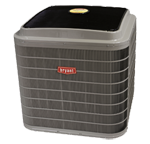
Air conditioners may look similar, but their Seasonal Energy Efficiency Rating (SEER/SEER2 and EER/EER2) can vary widely. For air conditioners, the Department of Energy’s (DOE) new minimum efficiency standards vary by region, so your choice of AC units will depend on where you live.
The DOE’s regional breakdown by state is as follows:
- North
- 14.0 SEER/ 13.4 SEER2
- Southeast
- 15.0 SEER/ 14.3 SEER2
- 12.2 EER/11.7 EER2
- Southwest
- 15.0 SEER/ 14.3 SEER2
- 12.2 EER/11.7 EER2
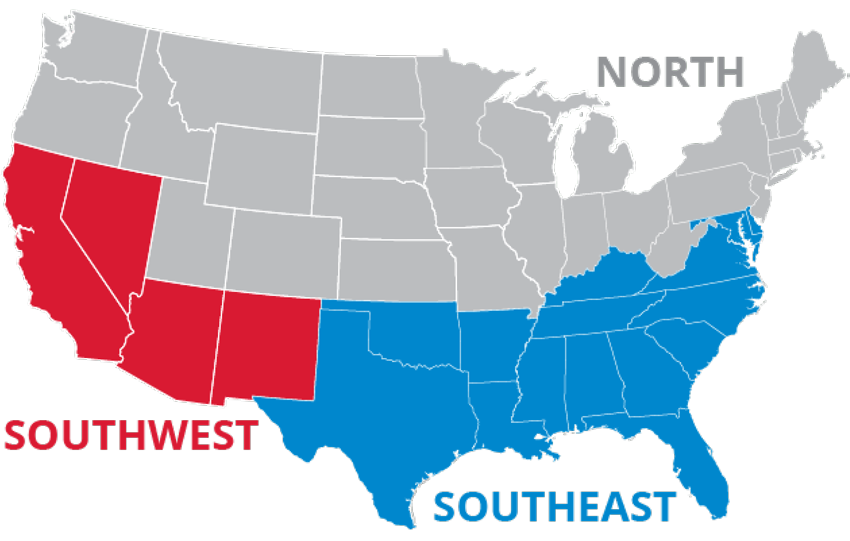
SEER Versus SEER2
SEER2 is an updated rating standard introduced by the DOE. SEER2 standards are intended to provide a better gauge of typical home operating conditions whereas the older SEER rating utilized very precise protocols to determine ratings in ideal conditions. SEER2 standards include updated testing means that give a better indication of how a unit will operate in the real world.
Much like miles-per-gallon for a car, SEER/SEER2 and EER/EER2 offer an easy way to compare efficiencies of different products – the higher the rating, the more efficient the unit. Just be sure you are comparing either SEER vs SEER or SEER2 vs SEER2 (same for EER/EER2).
EER2 Versus SEER2
EER2 and SEER2 both evaluate an air conditioner’s energy efficiency, but they’re concerned with two different types of temperature conditions:
- EER2 measures an air conditioner’s efficiency at the peak cooling temperature of 95°F.
- SEER2 measures an air conditioner’s efficiency throughout an entire cooling season, with temperatures ranging from 65°F to 104°F.
Colonial Heating & Cooling / Design Plumbing Can Help You Choose
We currently offer a line of air conditioners that meet the local minimum rating and go all the way up to a 24 SEER2. Depending on your average usage, higher SEER2/EER2 air conditioners can significantly reduce your electric bill.
Additionally, we offer many air conditioners that have advanced features, such as 2-stage compressors and variable speed fan operation. These features not only improve the comfort level of your home but can provide additional energy savings as well. Call us now at 614-837-6100.
Heat Pumps

Heat pumps are a great solution for your home comfort system when electricity is your only source of energy because they work to provide both heating and cooling. Heat pumps have SEER/SEER2 and EER/EER2 ratings like air conditioners and Heating Seasonal Performance Factor (HSPF/HSPF2) ratings for measuring heating efficiency.
The Department of Energy’s (DOE) new minimum efficiency national standard for Heat pumps is 15.0 SEER/14.3 SEER2/11.7 EER2 and 8.8 HSPF/7.5 HSPF2. This is a standard across the United States. Higher SEER/SEER2 and HSPF/HSPF2 ratings mean greater energy savings.
SEER/SEER2 and HSPF/HSPF2
SEER2 is an updated rating standard introduced by the DOE. SEER2 standards are intended to provide a better gauge of typical home operating conditions whereas the older SEER rating utilized very precise protocols to determine ratings in ideal conditions. SEER2 standards include updated testing means that give a better indication of how a unit will operate in the real world.
HSPF2 is the newest type of rating system that expands on the basic HSPF scale.
Much like miles-per-gallon for a car, SEER/SEER2, EER/EER2 and HSPF/HSPF2 offer an easy way to compare efficiencies of different products – the higher the rating, the more efficient the unit. Just be sure you are comparing either SEER vs SEER or SEER2 vs SEER2 (same for EER/EER2 and HSPF/HSPF2).
EER2 Versus SEER2
EER2 and SEER2 both evaluate an air conditioner’s energy efficiency, but they’re concerned with two different types of temperature conditions:
- EER2 measures an air conditioner’s efficiency at the peak cooling temperature of 95°F.
- SEER2 measures an air conditioner’s efficiency throughout an entire cooling season, with temperatures ranging from 65°F to 104°F.
Let Colonial Heating & Cooling / Design Plumbing Walk You Through All The Heat Pump Choices
Heat pumps are a very efficient alternative to electric baseboard heat alone. A heat pump works the same as an air conditioner in the summer, but it runs in reverse in the winter to heat your home. If needed, the system will be matched with a backup heating source, most often electric strip heating elements, for those extremely cold days of winter.
Just like our air conditioners, many of our heat pumps have advanced features, such as 2-stage compressors and variable speed fan operation. These features not only improve the comfort level of your home, but can provide additional energy savings as well. Call us now at 614-837-6100.
Air Handlers
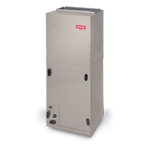
The air handler is the indoor component of a heat pump system. It includes the fan and the heating/cooling coil. The air handler is designed for a particular refrigerant, so it must be matched with the heat pump or air conditioner.
We offer many air handlers with variable and multi-speed features that can provide enhanced indoor comfort by slowly ramping up to your thermostat setting rather than simply turning on at full speed. This alleviates the "cold air blow" often associated with single speed air handlers, and dramatically reduces system noise.
Gas Furnaces
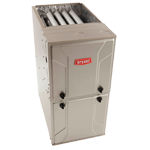
Today's new high efficiency furnaces can save up to 50% in operating costs over a ten-year-old furnace. Many 1990 and earlier model furnaces have Annual Fuel Utilization Efficiency (AFUE) ratings of 65% or less. The minimum AFUE rated furnace that can be sold in the United States today is 80% for the Southeast and Southwest, with 90% being the minimum in the North.
Our current product offering starts at 80% AFUE and goes all the way to a very efficient 98%+ AFUE rating. Depending on your average usage, higher AFUE rated furnaces can significantly reduce your gas bill.
The DOE’s regional breakdown by state is as follows:
- North – 80% AFUE
- Southeast – 90% AFUE
- Southwest - 90% AFUE

Let Colonial Heating & Cooling / Design Plumbing Help Pick The Right Furnace For Your Home
We offer many furnaces with variable and multi-speed features that can provide enhanced indoor comfort by slowly ramping up to your thermostat setting rather than simply turning on at full speed. This alleviates the "cold air blow" often associated with single speed furnaces, and dramatically reduces system noise. Call us now at 614-837-6100.
Packaged Units

Our complete line of packaged systems include Packaged Air Conditioners, Packaged Gas Furnaces and Air Conditioners, Packaged Heat Pumps and Packaged Hybrid Heat. These self-contained systems are located outside of the home, mounted on the ground or the roof, and ducted into the home.
Just like individual furnaces, air conditioners and heat pumps, these package units carry SEER/SEER2, EER/EER2, AFUE and HSPF/HSPF2 ratings. The higher the rating, the more energy efficient the unit is. The Department of Energy’s (DOE) new minimum efficiency standards vary by region, so your choice of package units will depend on where you live.
The DOE’s regional breakdown by state is as follows:
- North
- 14.0 SEER/ 13.4 SEER2
- 8.0 HSPF/6.7 HSPF2
- 80% AFUE
- Southeast
- 15.0 SEER/ 14.3 SEER2
- 8.0 HSPF/6.7 HSPF2
- 90% AFUE
- Southwest
- 15.0 SEER/ 14.3 SEER2
- 8.0 HSPF/6.7 HSPF2
- 90% AFUE

SEER/SEER2 And HSPF/HSPF2
SEER2 is an updated rating standard introduced by the DOE. SEER2 standards are intended to provide a better gauge of typical home operating conditions whereas the older SEER rating utilized very precise protocols to determine ratings in ideal conditions. SEER2 standards include updated testing means that give a better indication of how a unit will operate in the real world.
HSPF2 is the newest type of rating system that expands on the basic HSPF scale.
Much like miles-per-gallon for a car, SEER/SEER2, EER/EER2, AFUE and HSPF/HSPF2 offer an easy way to compare efficiencies of different products – the higher the rating, the more efficient the unit. Just be sure you are comparing either SEER vs SEER or SEER2 vs SEER2 (same for EER/EER2 and HSPF/HSPF2).
EER2 versus SEER2
EER2 and SEER2 both evaluate an air conditioner’s energy efficiency, but they’re concerned with two different types of temperature conditions:
- EER2 measures an air conditioner’s efficiency at the peak cooling temperature of 95°F.
- SEER2 measures an air conditioner’s efficiency throughout an entire cooling season, with temperatures ranging from 65°F to 104°F.
Right-Size Your HVAC Packaged Units. Give Colonial Heating & Cooling / Design Plumbing A Call Today!
We carry a wide offering that includes advanced features such as 2-stage compressors, variable speed fans and quiet operation. Call us now at 614-837-6100.
Hybrid Heat
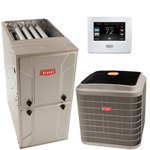
With a traditional heating and cooling system, if you wanted to save more, you had to use less. But a Hybrid Heat system combines the benefits of intelligent control for both gas and electric heating to create an intuitive system that can actually react to changing conditions.
No matter what the temperature is outside, a Hybrid Heat system will automatically select the fuel source most efficient for your home, which means you'll stay warm in the winter, cool in the summer and save money all year long.
To design a Hybrid Heat system for your home, we professionally match one of our heat pump units with a natural gas furnace. Contact us to see how much energy you can save over your existing system.
Geothermal
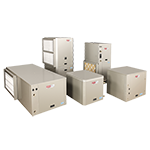
The Earth absorbs almost 50% of all solar energy and remains a constant temperature of 50°F to 70°F depending on geographical location. A geothermal unit utilizes this constant temperature for heating and cooling your home.
You can realize up to 60% energy savings vs. traditional systems. There is no flame, no flue, no odors and no loud outdoor equipment. Heating, air conditioning and hot water can all be attained from a single compact unit.
Duct Free Systems
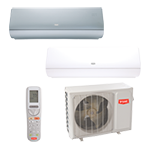
Duct free heating and cooling systems make your home's individual rooms or other small spaces more comfortable. Remember, just like whole-home systems, the higher the SEER/SEER2 and HSPF/HSPF2 ratings, the more efficient they will be.
The DOE’s regional breakdown by state is as follows:
- North
- 14.0 SEER/ 13.4 SEER2
- 8.8 HSPF/7.5 HSPF2
- Southeast
- 15.0 SEER/ 14.3 SEER2
- 12.2 EER/11.7 EER2
- 8.8 HSPF/7.5 HSPF2
- Southwest
- 15.0 SEER/ 14.3 SEER2
- 12.2 EER/11.7 EER2
- 8.8 HSPF/7.5 HSPF2

SEER/SEER2 And HSPF/HSPF2
SEER2 is an updated rating standard introduced by the DOE. SEER2 standards are intended to provide a better gauge of typical home operating conditions whereas the older SEER rating utilized very precise protocols to determine ratings in ideal conditions. SEER2 standards include updated testing means that give a better indication of how a unit will operate in the real world.
HSPF2 is the newest type of rating system that expands on the basic HSPF scale.
Much like miles-per-gallon for a car, SEER/SEER2, EER/EER2 and HSPF/HSPF2 offer an easy way to compare efficiencies of different products – the higher the rating, the more efficient the unit. Just be sure you are comparing either SEER vs SEER or SEER2 vs SEER2 (same for EER/EER2 and HSPF/HSPF2).
EER2 vs. SEER2
EER2 and SEER2 both evaluate an air conditioner’s energy efficiency, but they’re concerned with two different types of temperature conditions:
- EER2 measures an air conditioner’s efficiency at the peak cooling temperature of 95°F.
- SEER2 measures an air conditioner’s efficiency throughout an entire cooling season, with temperatures ranging from 65°F to 104°F.
Call Colonial Heating & Cooling / Design Plumbing To Find Out If Duct-Free Systems Are Right For You.
We offer a variety of through-the-wall packaged terminal air conditioners (PTAC) and duct free heating and cooling systems to meet any individual room's needs. Call us now at 614-837-6100.
Thermostats
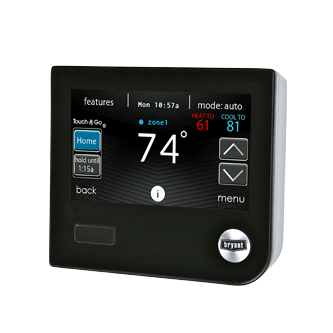
Thermostats are used to turn on heating or cooling systems to bring the home to a set temperature. In addition to basic temperature control, programmable thermostats can be used to manage the indoor environment of your home at different times of the day or week. This type of control can have a dramatic impact on the overall energy use of your home. We carry a complete line of thermostats. Let us help you choose the one that best matches your lifestyle.
Zoning Products
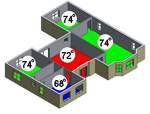
Zoning can provide optimum comfort with increased energy savings in your home by dividing a home into areas with similar heating and cooling needs and independently controlling the temperature in each area. Much like multiple light switches that independently control lighting in different rooms, with zoning, multiple zone thermostats or sensors control temperature in different areas of the home. Contact us for an in-home evaluation and estimate.
Air Cleaners
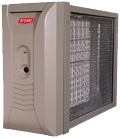
Air cleaners effectively remove bacteria, pollen, animal dander and other pollutants as small as 0.01 microns. That's 18,000 times smaller than the head of a pin. The higher the Minimum Efficiency Reporting Value (MERV), the more efficiently the cleaner removes particles. We offer air cleaners that range from MERV 10 to MERV 15 to meet your needs. For those families that have severe allergies, we also offer Whole House High Efficiency Particulate Arresting (HEPA) filtration systems.
Humidifiers
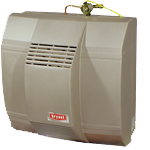
Humidifiers work in tandem with your heating system to deliver desired humidity levels throughout your home. Maintaining proper humidity levels in your home is essential to maintaining indoor comfort during the winter months. Moderate humidity levels make you feel warmer at lower temperatures, which means you can set your thermostat lower without sacrificing comfort.
Depending on the size of your home, we offer a variety of humidifiers to deliver the right amount of moisture into the air. Sizing of humidifiers is measured in Gallons Per Day (GPD), and we offer models from 12 GPD to 18 GPD.
Dehumidifiers

Too much humidity harms your immediate environment. Estimates suggest that the average family can produce over 11 liters of excess moisture every single day. While this affects the house in obvious ways, like mold, damp patches and spoiled surfaces, it also affects people's health in more important ways, aggravating conditions like asthma, arthritis and rheumatism.
Dehumidifiers work in tandem with your heating and cooling system to maintain desired humidity levels throughout your home. Maintaining proper humidity levels in your home is essential to maintaining indoor comfort during the summer months. Lower humidity levels make you feel cooler at warmer temperatures, which means you can set your thermostat higher without sacrificing comfort.
Depending on the size of your home, we offer a variety of dehumidifiers to remove the right amount of moisture from the air.
Ventilators
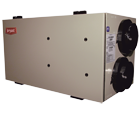
Ventilators bring fresh air into your home without losing heating or cooling energy. Their unique energy exchange system transfers the heating or cooling energy from the stale air being exhausted from your home to the fresh air the ventilator brings into your home.
If your family suffers from allergies, ventilators are a much better alternative for introducing fresh air into your home versus opening your windows. They also do a great job of reducing cooking and pet odors, smoke and other pollutants out of your home.
How it works:
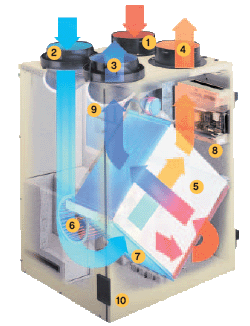

- Internal air intake - draws in stale indoor air, directing it through the heat exchanger core.
- External air intake - draws outside air, venting it through the air filter.
- Internal air exhaust - vents indoor air outside from the heat exchanger core. Up to 84% of the indoor heat has been removed, helping minimize utility costs.
- Fresh air exhaust - vents conditioned, heated outdoor air into your living areas.
- High efficiency heat recovery core - extracts heat from stale indoor air and transfers it to fresh outdoor air for maximum comfort with little heat loss. This core also removes excess humidity from recirculated air - lower humidity levels help you stay comfortable at higher temperatures in the summer and lower temperatures in the winter.
- Ventilator motor - moves air through the system efficiently and quietly.
- Air filter - cleans outdoor air of small particles before they circulate through your home.
- Electronic circuit board - adjusts air circulation modes and motor speeds.
- Damper defrost - helps prevent frost from forming within the system, eliminating the need for a supplemental energy -consuming electric defroster. This defroster engages when temperatures drop below 23 degrees Fahrenheit.
- Briefcase-style exterior latches - allow easy filter changes with no tools required.
- Simple wall control - makes operating the HRV easy and convenient.
UV Lights
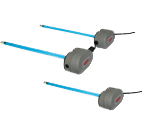
Ultraviolet light kills bacteria and mold growing on your indoor coil before they are circulated throughout your home. UV lamps are installed near your existing indoor coil and work diligently to rid your home of the bacteria, viruses, mold and germs that impact your home's health. We install 1 or 2 lights per indoor coil, depending on the size of the coil.
Carbon Monoxide Detectors
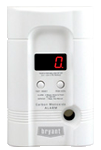
Carbon Monoxide (CO) is a colorless, odorless, and tasteless gas which makes it extremely dangerous. CO detectors can protect your family from deadly carbon monoxide gas. Fuel-burning appliances such as oil and gas furnaces, gas water heaters, gas ranges and ovens, gas dryers, gas or kerosene space heaters, fireplaces and wood stoves are all sources of carbon monoxide.
A monitored carbon monoxide detector will alert you if high levels of this deadly gas are detected. Local building ordinances require the installation of carbon monoxide detectors in your home. An expert technician from Colonial Heating & Cooling / Design Plumbing can properly install your CO detector and ensure it's functioning correctly.
Garage Heaters
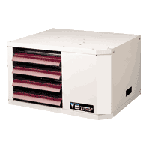
When winter hits, there's one area that we often wish was warmer than it is; the garage. If you have a detached garage that houses your vehicles or workshop, you may want to consider looking at a garage heater. These can not only make the air in the building warmer and more comfortable, but it can actually help when it comes to warming up the car or truck in the morning. We offer a wide selection of electric and gas garage heating systems.
Radiant Heating
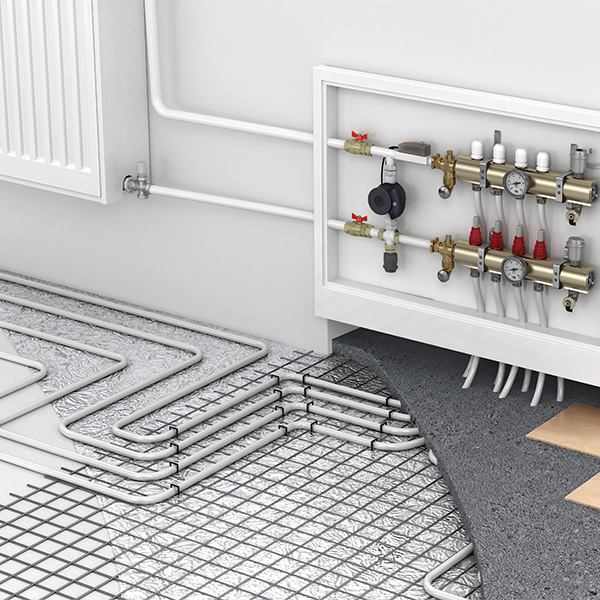
Radiant heating is used every day in many ways. It is a way of heating unlike conventional means (normally convection). We offer countless products that heat both indoors and outdoors substantially. Call us for more information on our radiant heating products.
Water Heaters
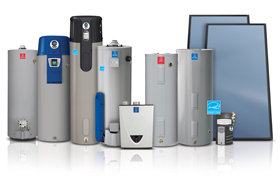
After heating and cooling, water heating is typically the largest energy user in the home because it is necessary for so many domestic activities. The capacity of a water heater is an important consideration. The water heater should provide enough hot water at the busiest time of the day. We offer a wide variety of electric, gas and tankless water heaters.
Water Filtration Systems
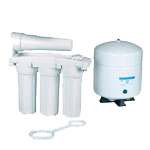
One of the most important things you can do for your family's health is to ensure clean, pure drinking water is flowing from your taps. With quality products from Watts, we can help you meet that goal. There are particles, disolved organics, disolved inorganics and bacteria in your tap water that can be removed using various type of filtration processes. Here is a brief explanation of each:
Sediment Filtration
Sediment filtration uses a filter media to trap particulates out of the water. The filter media comes in the different styles of depth, screen and surface filters, all with the function of removing sediment from the water. Using the right combination can be highly effective and be the most cost effective way to eliminate sediment from your water.
Taste & Odor Filtration
Filter media usually doesn't trap the dissolved inorganics and other contaminants that effect your water's taste and smell. Using activated carbon filtration to absorb these contaminants from the water is the best way to eliminate odor and taste issues. The carbon adsorption process is controlled by the diameter of the pores in the carbon filter and by the diffusion rate of organic molecules through the pores. The rate of adsorption is a function of the molecular weight and the molecular size of the organics. Carbon is usually used in combination with other treatment processes. The placement of carbon in relation to other components is an important consideration in the design of a water purification system.
Reverse Osmosis
Reverse osmosis (RO) is the most economical method of removing 90% to 99% of all contaminants. The pore structure of RO membranes is much tighter than UF membranes. RO membranes are capable of rejecting practically all particles, bacteria and organics. In fact, reverse osmosis technology is used by most leading water bottling plants.
Reverse osmosis is highly effective in removing several impurities from water such as total dissolved solids (TDS), turbidity, asbestos, lead and other toxic heavy metals, radium, and many dissolved organics. The process will also remove chlorinated pesticides and most heavier-weight VOCs. Reverse osmosis and activated carbon filtration are complementary processes. Combining them results in the most effective treatment against the broadest range of water impurities and contaminants.
Plumbing Fixtures
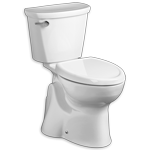
Toilets
Almost all toilets have a similar tank capacity. When choosing a tank, you'll have flush valve size and flush lever positioning to consider, as well as the flushing system.
The flush valve, which is located at the center of the tank, is activated by the flush lever and releases the water held in the tank. The larger the flush valve, the higher the rate of water flow. Flush levers are positioned either on the side, front or top of the tank.
The pressure-assisted and gravity-flush systems are the two standard flushing systems available:
Pressure-Assisted Flush System: Pressurized air forces water into the bowl when flushed, reducing the chance for clogs. This system is noisy, expensive and may require costly maintenance.
Gravity-Flush System: The most common and simplest system, it uses the water weight to generate flushing pressure. The pressure forces everything from the tank into the bowl and through the S-shaped trapway. A siphoning action completes the flush. This flushing system is quieter and requires less maintenance than a pressure-assisted flushing system.
Additional toilet technology includes:
Dual Flush: This is a relatively new system for saving water without sacrificing efficiency. There are two flushing options for a full or partial flush (ex. 1.6 gallon flush and 1.1 gallons per flush).
Waterless Toilets: Where water or plumbing is not available or when portability is required, a self-contained waterless unit is an option.
Kitchen & Bathroom Sinks
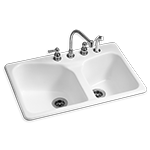
The kitchen may be the heart of the home, but the sink handles most of the daily chores. That's because it's the only working area used to both prepare meals and clean up after them. Although quality sinks can last 15 years or more, they do wear out. If you're planning a kitchen remodel, it makes sense to replace your sink and faucet.
Kitchen Sink Size vs. Kitchen Size
With so many options — single bowls to multiple bowls of different sizes, shapes and depths — you need to consider the size of the room and how you'll use the sink. Large multibasin models, which are popular right now, will overpower a small kitchen.
What material best suits your needs?
There are many kitchen sink materials to choose from, including stainless-steel, enameled cast iron, quartz silicate and solid surface:
- A high-quality, 18-gauge stainless-steel sink will take a lot of abuse
- Enameled cast iron has endless options for shiny colors
- Solid surface or quartz silicate is better at resisting scratches
Here's what to consider when choosing a new bathroom sink style:
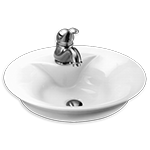
Pedestal
A good choice for powder rooms and guest baths where storage is less important and space is limited. Their sleek, sophisticated lines can visually enlarge a room, while also enhancing its appearance. Pedestal sinks come in a variety of styles and shapes.
Wall-Mount
Wall mount sinks feature a basin that it hung from the wall at a location and height that you choose. Lately, these sinks have seen a rapid gain in popularity. In part because there are so many attractive and innovative designs available, but also because they're ideal for universal access applications.
Undercounter
Clean, modern, distinctive. That's the beauty of undercounter sinks. They free up usable counter space, and since there is no rim to catch debris, they're also the easiest type of sink to keep clean.
Above Counter/Vessel
Versatile and stylish, above-counter sinks rise above the countertop, console or cabinet to create a dramatic focal point. They are best suited for master baths and powder rooms, especially in contemporary, cosmopolitan homes. Keep in mind that since these sinks sit above the countertop, the countertop should be lower than normal to allow easy access to the sink. Also consider what type of faucet to use with a vessel sink. Tall vessel faucets work well along with wall mounted faucets.
Countertop
These sinks, also called drop-ins and self-rimming, fit into a variety of countertops. And thanks to their self-rimming nature, they're the simplest type to install. Countertop sinks are the style most commonly found in high-traffic family bathrooms.
Integral Countertop
These sinks combine a countertop and sink together. Their one piece, seamless design allows for a clean, sleek look. Since there are no crevices they are also one of the easiest styles to keep clean.
Bathtubs
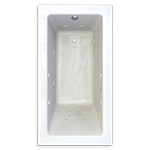
If you're remodeling and looking to add a new bathtub to your bathroom, find out what options are available for bathtub types, installation options, and materials to find the perfect tub for your bath and budget.
Find the Right Type of Tub for You
Some tubs are all function, while others focus on indulgence. Let the primary use dictate your selection as you determine what works best for your household.
Standard: This affordable, jack-of-all-trades built-in basic is often found in an alcove installation and doubles as a tub-shower combo; it can be purchased at your local home improvement center.
Whirlpool & Air Tubs: Think of it as an on-demand therapeutic massage in your home. A whirlpool forces water through strategically placed jets, and an air tub pushes a soothing, steady stream of air into the water. With the extra plumbing required, whirlpools tend to be more expensive than air tubs. Visit a showroom or chat with your designer to determine which option best fits your preference and space.
Soaking: Extra-deep dimensions allow the bather's body to be completely submerged. It can be either built-in or freestanding. Walk In: Climbing in and out of a slippery tub can be dangerous, but a walk-in tub is great for those with mobility concerns.
Showers
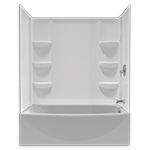
Need a bathtub and a shower but don't have the room for separate pieces in your bathroom? A space-saving combination tub-shower is a smart choice. These two-in-one units make the most of limited space by providing all the benefits of both a shower and a bathtub in a compact footprint, which can be particularly useful in a child's or guest bathroom. When you don't have room or funds for a separate tub and shower, a combo model is also a wise choice for boosting your home's resale value because it serves homeowners who prefer either option.
Tub and shower combos are available as prefabricated kits or can be installed as a custom design. Typically made from fiberglass or acrylic, prefab units are available from very basic and affordable models to pricey versions that include tile-look walls, modern colors, and shelves. Although the design options are limited with prefab units, you can personalize the unit with the fixtures you choose. A glass shower door can also give the illusion of more space than a curtain. A sliding door is installed on a track along the edge of the bathtub.
Let the experts at Colonial Heating & Cooling / Design Plumbing help explain all the details and customize a solution that's right for you.
Sump Pumps
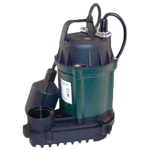
At Colonial Heating & Cooling / Design Plumbing, we offer a variety of solutions that can handle any of your wastewater issues. From standard sump pumps to innovative water powered pumps, we can recommend the products that will protect your property from damage. Our commitment to using the best technology and extensive industry experience makes us the best option to handle all of your home or commercial wastewater needs.
We offer solutions with the following products:
Sump Pumps
A sump pump is the first line of defense if your basement floods, so it is important that you choose the right solution for your home.
What is a Sump Pump?
A sump pump is a small pump found at the lowest part of a crawlspace or basement. It works to keep the area under a building dry and to prevent flooding. These pumps are usually installed in sump pits, and their job is to pump water out of the pit and away from the structure.
How it Works
As the sump pit in your crawlspace or basement fills with water, a sump pump should automatically turn on when a float activator arm is triggered. The float activator will work similar to a toilet tank – a buoyant ball will float on the top of the water before tripping the pump switch once the water reaches a specific level.
The sump pump then works to move liquid out of the pit and through a series of pipes that lead away from your home. The water will drain to a safe place away from your property’s foundation, and because the pipe includes a one-way check valve, it should not flow back into the pit.
Battery Backup Sump Pumps
Unfortunately, electricity isn’t always reliable, so it is important to have a backup solution in place in the event that your property experiences a wastewater event. A battery backup sump pump isn’t connected to your home’s electrical system, and it runs off of a battery. It is usually found in the same place as the main pump, although it should be slightly elevated.
Why Do You Need a Battery Backup Sump Pump?
After you invest in a sump pump, you may be wondering why you would need an additional backup pump. Unfortunately, like all systems, primary sump pumps have a limited lifespan. They could fail for several reasons, and a backup system will be there in case of an emergency:
- Power outage. Should your electricity go out, your battery backup pump will activate.
- Float switch malfunctions. Should your float switch malfunction, rising water levels can automatically activate your backup system.
- Primary pump failure. Should your primary pump fail completely, the backup sump pump will automatically take over.
- Failure to keep up with water inflow. If the primary pump simply can’t keep up with the inflow of water, backup system activation can help lessen the load.
Don’t wait until a wastewater emergency to find out your primary pump isn’t working or can’t handle the job. Invest in a battery backup system today.
Water Powered Pumps
If you are in need of a backup option to your primary electric sump pump, a water powered pump is a great solution.
What is a Water Powered Pump?
A water powered pump provides you with an efficient way to pump out water without a battery backup or the use of electricity. As long as you have access to city water, you’ll have a working pump and dry basement – even in the event of a power failure. Unfortunately, this won’t be an option for homes that use well water.
How it Works
Water powered sump pumps work because of the Venturi effect. When connected to city public works, water will flow through the pump. The constriction that results will cause a reduction in pressure that literally sucks water out of the sump pit. The water will then combine with your home’s flowing city water before exiting the basement via a discharge line.
Sewage Ejector Systems
Also known as a sewage ejector pump, these systems closely resemble sump pumps, but they have been designed for specific use in sewage applications.
What is a Sewage Ejector System?
Sewage ejector systems are used when a laundry room, bathroom, or other plumbing fixture is installed below the main septic or sewer line grade. They are typically installed in basements and are part of a larger system designed to pump both liquids and solids.
There is a key distinction between sewage ejection systems and waste water sump pumps – a vent. With a sewage ejector pump, a vent needs to be installed to run from the sump pump through the room. The top of the sump pit will be sealed so that no waste or odors can seep out of the basin.
How it Works
Sewage ejector systems are intended to sit in their own sump pit and should be kept away from your normal waste water sump pit. Similar to a sump pump, when waste water levels in the pit reach a certain height, a float is tripped. The waste water is then pumped up and out of the basin and to ground level. From there it is pumped to the sewer or septic tank.
If you are in need of a sump pump for your home or business, it is important to make the right selection. Let us help you to explore your options and create the best possible solution.
Garbage Disposals

While garbage disposals can be a great convenience in the kitchen, a clogged or worn out garbage disposal can become a huge plumbing problem.
Garbage disposals can be damaged if objects like sponges, silverware, or other non-food items end up in the disposal. If yours is sounding bad when running or is backed up and clogged, it is time to give us a call.
Call Colonial Heating & Cooling / Design Plumbing at 614-837-6100 now, we handle:
- Garbage disposal repair
- Clearing clogged garbage disposals
- Garbage disposal installation
Leak Detectors
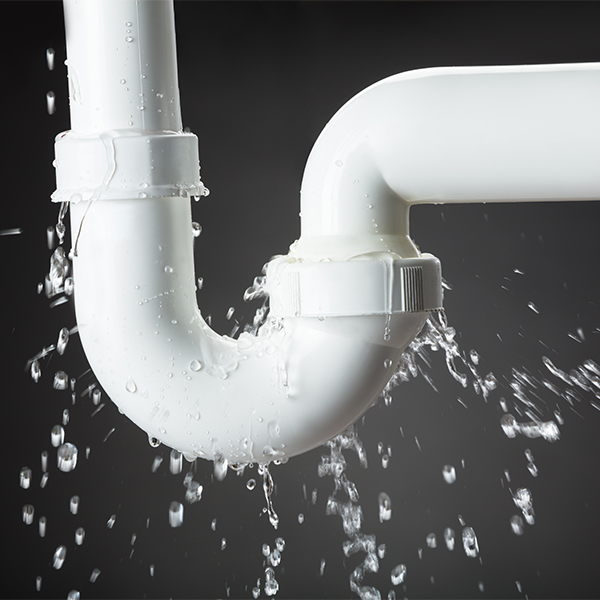
Small cracks in a plumbing pipe can lead to huge, expensive problems later on in walls, ceilings and foundations. Damage from a water pipe leak is up to 6 times more likely than by fire in your home. These types of leaks can cost you thousands of dollars in not only utility bills but property damage as well.
Leak detectors monitor your supply-side plumbing pipes 24 hours a day. They can alert you when a leak is detected and automatically shut off the water to your house. Depending on the type of detector, they can notify by:
- Audible Alarm
- Smartphone app (perfect for when you are away)
Call Colonial Heating & Cooling / Design Plumbing at 614-837-6100 now, we handle the installation of leak detectors!
Ejector Pumps

What is a Sewage Ejector System?
Sewage ejector systems are used when a laundry room, bathroom, or other plumbing fixture is installed below the main septic or sewer line grade. They are typically installed in basements and are part of a larger system designed to pump both liquids and solids.
There is a key distinction between sewage ejection systems and waste water sump pumps – a vent. With a sewage ejector pump, a vent needs to be installed to run from the sump pump through the room. The top of the sump pit will be sealed so that no waste or odors can seep out of the basin.
How it Works
Sewage ejector systems are intended to sit in their own sump pit and should be kept away from your normal waste water sump pit. Similar to a sump pump, when waste water levels in the pit reach a certain height, a float is tripped. The waste water is then pumped up and out of the basin and to ground level. From there it is pumped to the sewer or septic tank.
If you have a sewer ejector pump in your home, you definitely want to keep it in good working order! This pump ensures that everything you flush down the toilet or down the drain gets pumped out of the house and into the sewer or septic line.
Regular maintenance is critical to keeping these pumps in good working order providing reliable service.
Colonial Heating & Cooling / Design Plumbing has the expertise to service, repair and replace ejector pumps. Below are some of the best that we install. Call us today at 614-837-6100 to schedule your ejector pump maintenance.
Instant Hot Water Dispensers
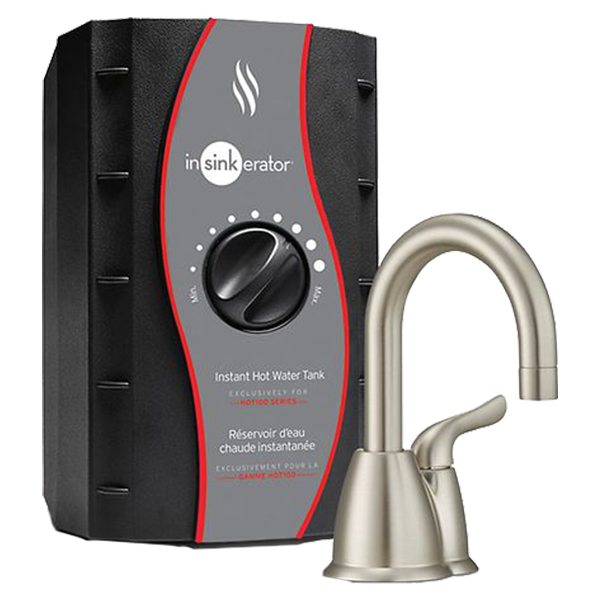
Ready to upgrade your kitchen with an instant hot water dispenser? Having the convenience of on demand hot water is one of life's little luxuries.
Colonial Heating & Cooling / Design Plumbing has the expertise to install, repair and replace instant hot water dispensers. Below are some of the best that we install. Call us today at 614-837-6100 to schedule your repair or new installation.

